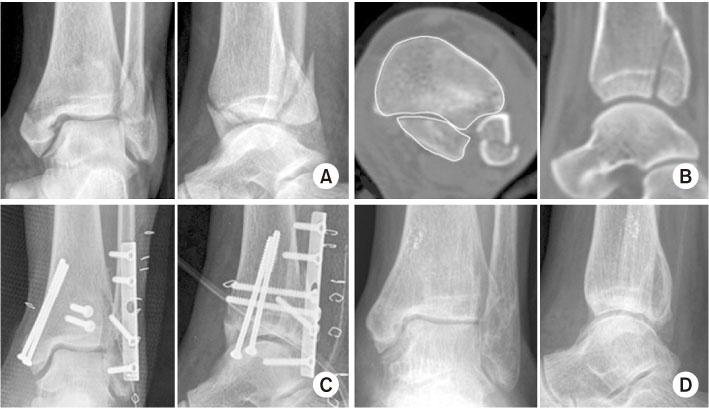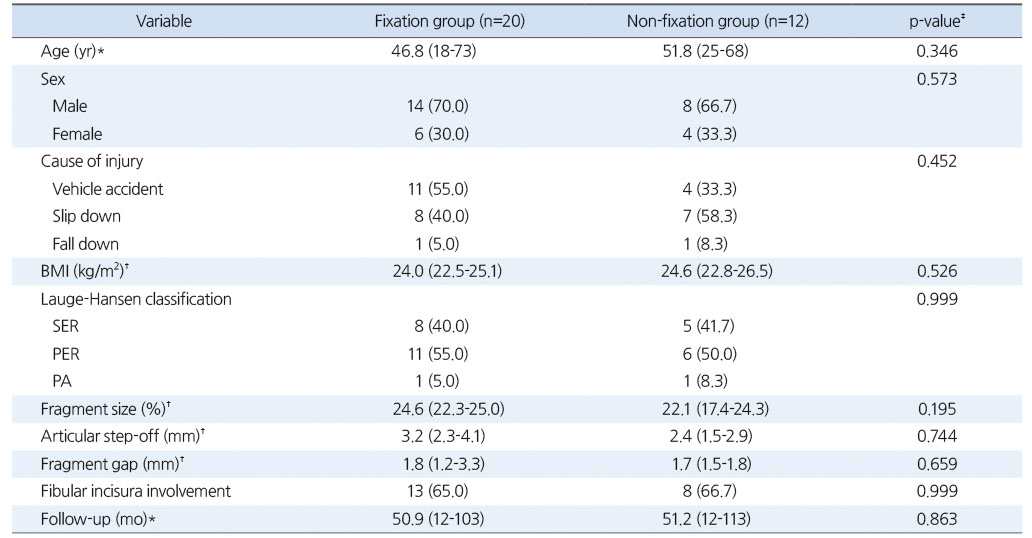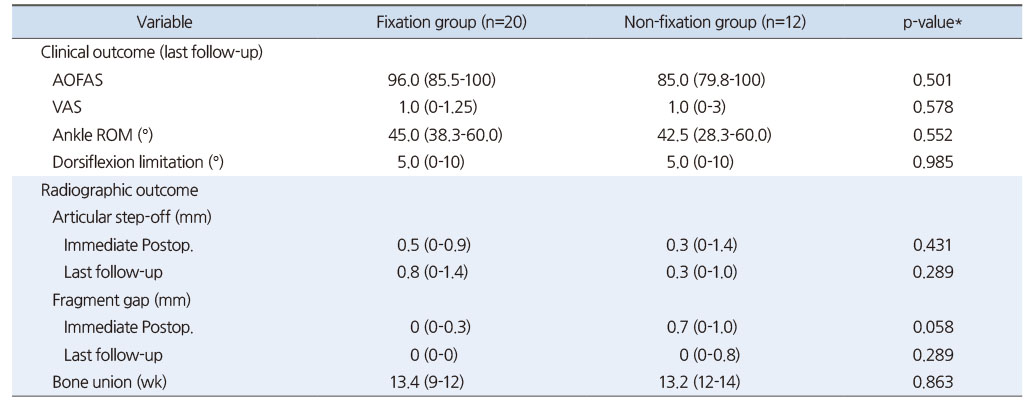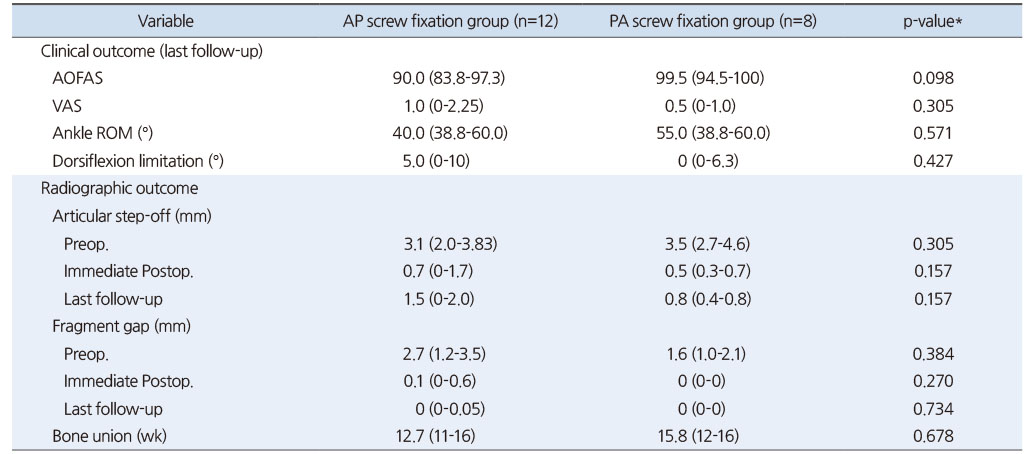Articles
- Page Path
- HOME > J Musculoskelet Trauma > Volume 34(1); 2021 > Article
- Original Article Comparing Outcomes of Screw Fixation and Non-Fixation for Small-Sized Posterior Malleolar Fragment in Ankle Trimalleolar Fractures
- Jee-Wook Ko, Gun-Woo Lee, Keun-Bae Lee
-
Journal of Musculoskeletal Trauma 2021;34(1):8-15.
DOI: https://doi.org/10.12671/jkfs.2021.34.1.8
Published online: January 31, 2021

- 508 Views
- 8 Download
- 0 Crossref
- 0 Scopus
Abstract
Purpose
This study was undertaken to compare outcomes of screw fixation and non-fixation of a small-sized posterior malleolar fragment involving less than 25% articular surface in ankle trimalleolar fractures.
Materials and Methods: A total of 32 consecutive ankles (32 patients), with posterior malleolar fragment involving 15%-25% of the joint surface, were enrolled in the study. Patients were divided into 2 groups according to whether the fragment was fixed or not (fixed: 20 ankles, non-fixed: 12 ankles).
The minimum follow-up period was 12 months. Median size of the posterior malleolar fragment in the fixed and non-fixed groups were 24.6% (range, 22.3%-25.0%) and 22.1% (range, 17.4%-24.3%), respectively. Complications as well as clinical and radiographic outcomes were compared and analyzed between the two groups.
Results: Clinical outcomes, including American Orthopaedic Foot & Ankle Society (p=0.501), visual analogue scale (p=0.578), and ankle range of motion (p=0.552), showed no difference between groups at the final follow-up. No differences were obtained in the radiographic outcomes, including joint stepoff (p=0.289) and fragment gap (p=0.289). Complications, including 1 case of delayed union and 1 case of wound infection, were reported in the fixed group.
Conclusion: Clinical outcomes and radiographic outcomes of the non-fixation group were satisfactory and comparable to the fixation group. Our results indicate that anatomical reduction with small-sized posterior malleolar fragment in ankle trimalleolar fractures is sufficient for satisfactory outcomes, without the need for additional internal fixation.
Published online Jan 25, 2021.
https://doi.org/10.12671/jkfs.2021.34.1.8
Comparing Outcomes of Screw Fixation and Non-Fixation for Small-Sized Posterior Malleolar Fragment in Ankle Trimalleolar Fractures
Abstract
Purpose
This study was undertaken to compare outcomes of screw fixation and non-fixation of a small-sized posterior malleolar fragment involving less than 25% articular surface in ankle trimalleolar fractures.
Materials and Methods
A total of 32 consecutive ankles (32 patients), with posterior malleolar fragment involving 15%–25% of the joint surface, were enrolled in the study. Patients were divided into 2 groups according to whether the fragment was fixed or not (fixed: 20 ankles, non-fixed: 12 ankles). The minimum follow-up period was 12 months. Median size of the posterior malleolar fragment in the fixed and non-fixed groups were 24.6% (range, 22.3%–25.0%) and 22.1% (range, 17.4%–24.3%), respectively. Complications as well as clinical and radiographic outcomes were compared and analyzed between the two groups.
Results
Clinical outcomes, including American Orthopaedic Foot & Ankle Society (p=0.501), visual analogue scale (p=0.578), and ankle range of motion (p=0.552), showed no difference between groups at the final follow-up. No differences were obtained in the radiographic outcomes, including joint stepoff (p=0.289) and fragment gap (p=0.289). Complications, including 1 case of delayed union and 1 case of wound infection, were reported in the fixed group.
Conclusion
Clinical outcomes and radiographic outcomes of the non-fixation group were satisfactory and comparable to the fixation group. Our results indicate that anatomical reduction with small-sized posterior malleolar fragment in ankle trimalleolar fractures is sufficient for satisfactory outcomes, without the need for additional internal fixation.
Fig. 1
(A) Method of measuring proportion of the posterior malleolar fragment by calculating length of the fragment on lateral plain radiograph; a/(a+b). (B) In the current study, ratio of the posterior malleolar fragment to the joint surface was measured on the axial image of computed tomography at the level corresponding to the distal tibia joint surface, using automatic area calculating tool of the PACS system; a/(a+b).
Fig. 2
(A) A 56-year-old female sustained a rotational ankle fracture with a posterior malleolar fracture. (B) Articular involvement of posterior malleolar fragment to the joint surface area of the distal tibia was 19.0% on axial computed tomography (CT) imaging. Preoperative step-off and fragment gap were 2.0 mm and 2.5 mm, respectively, on the sagittal CT imaging. (C) The posterior malleolar fragment was fixed using a posterior to anterior lag screw. (D) At 27 months postoperatively, the fracture site was well united without step-off, and showed a mild joint irregularity at the fracture site.
Fig. 3
(A) A 68-year-old male sustained a rotational ankle fracture with a posterior malleolar fracture. (B) Articular involvement of posterior malleolar fragment to the joint surface area of the distal tibia was 23.6% on the axial computed tomography (CT) imaging. Preoperative step-off and fragment gap were 2.0 mm and 1.5 mm, respectively, on the sagittal CT imaging. (C) After reduction of the lateral malleolus, the posterior malleolar fragment was not fixed. (D) At 24 months postoperatively, the fracture site union was achieved, with no articular step-off and joint irregularity.
Table 1
Demographic Data and Preoperative Radiographic Results of Fixation and Non-Fixation Groups for Posterior Malleolar Fragment in Ankle
Trimalleolar Fractures
Table 2
Comparison of Clinical and Radiographic Outcomes of Fixation and Non-Fixation Groups for Posterior Malleolar Fragment in Ankle Trimalleolar Fractures
Table 3
Comparison of Clinical and Radiographic Outcomes of AP Screw and PA Screw Fixation Groups for Posterior Malleolar Fragment in Ankle Trimalleolar Fractures
Financial support:None.
Conflict of interests:None.
References
-
Solan MC, Sakellariou A. Posterior malleolus fractures: worth fixing. Bone Joint J 99. B 2017:1413–1419.
-
-
O'Connor TJ, Mueller B, Ly TV, Jacobson AR, Nelson ER, Cole PA. “A to p” screw versus posterolateral plate for posterior malleolus fixation in trimalleolar ankle fractures. J Orthop Trauma 2015;29:e151–e156.
-

 E-submission
E-submission KOTA
KOTA TOTA
TOTA TOTS
TOTS








 Cite
Cite

